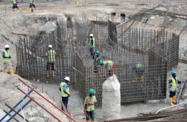A favourable macroeconomic outlook – aided by a growing population, infrastructure investments and rising consumption – is driving the expansion of Nigeria’s cement market, with a number of large investments in capacity in the offing.
Cement output grew 15.6% to 21.2m tonnes in 2013, according to local press. Production has increased by an average of 10.9% a year since 2004, despite the effects of the international economic crisis and domestic political instability.
Strong fundamentals – including headline GDP growth of more than 7% – indicate expansion can continue in the medium to long term. There is certainly plenty of scope for increased demand. Nigeria’s per capita cement consumption was 126 kg in 2013, compared to a global average of 510 kg, according to the Global Cement Report 10th Edition, published by International Cement Review on March 31.
The robust performance in the building materials segment has been good news for producers. The largest supplier, locally owned Dangote Cement, is reaping the rewards of growth: on March 26, the company reported that net profits rose 39% in 2013, thanks in part to a 28% rise in sales in Nigeria, to 13.3m tonnes. The firm plans to invest $1bn in plants across Africa in 2014, including completing its Ibese and Obajana factories in Nigeria.
Capacity upgrades are being put in place across the sector. The Nigerian unit of Lafarge Cement has also announced it will invest an additional €1bn ($1.4bn) in Nigeria over the next three to four years to double its capacity to 16m tonnes. Local Ashaka cement is also expanding, preparing to launch a €513m ($707.3m) cement plant with linked power station in Gombe.
The reasons for confidence in the outlook are clear enough – economics and demographics. The Nigerian economy has expanded by an average of 6% annually since 2006, according to World Bank figures. It is expected to achieve a rate of 7.4% this year, IMF data show. The population is growing by more than 2% per year, while urbanisation is a strong trend. The building and construction and real estate sectors have been expanding at double-digit rates in recent quarters.
Housing to drive demand
Efforts to alleviate the housing shortage are set to drive demand for both construction materials and services. According to a late 2012 estimate by the government, an extra 15m-20m residential units are needed. This figure has been growing steadily over the past few decades as investment has failed to keep pace with demand.
A spate of well-intentioned government initiatives is looking to stoke increases in supply. In January, President Goodluck Jonathan launched the Nigeria Mortgage Finance Company, which aims to improve access to lower-cost mortgage financing. The scheme is a public-private partnership backed by a zero-interest loan of $250m from the World Bank, and will be further financed by a N50bn ($300m) bond issue. The 75,000 new homes a year that it should fund will be a boost to the construction sector – though still falling short of the new supply needed.
Demand from the private sector is also rising, with massive developments in the works, such as the Eko Atlantic project in Lagos, which is designed to be home to 250,000 residents, with a further 150,000 commuting there daily for work.
Subhead Investments to upgrade infrastructure
The government has also reiterated its commitment to infrastructure development across the country, an area that has in the past suffered from underinvestment and mismanagement. In March, the Nigeria Sovereign Investment Authority, NSIA, announced plans to invest in a range of projects including motorways, real estate and the power sector, to which it has committed $100m.
Exports present additional opportunities for Nigeria’s cement manufacturers, particularly for those with larger capacities, such as Dangote and Lafarge. In March 2013, Dangote started shipping cement to Ghana from its Ibese plant, and Dangote Group president Aliko Dangote told local press he saw substantial potential for sales to other sub-Saharan African countries, particularly those with a lack of limestone resources.
There is still plenty of room for improving profitability ratios and efficiency, however. Cement production in Nigeria – as with any manufacturing activity – faces a number of challenges. Constraints come from cost factors, particularly of power, which accounts for around 50% of the cost of a bag of cement in Nigeria, according to Alhaji Umaru Kwairanga, chairman of Ashaka, as well as competition from other exporters.
Follow Oxford Business Group on Facebook, Google+ and Twitter for all the latest Economic News Updates. Or register to receive updates via email.

